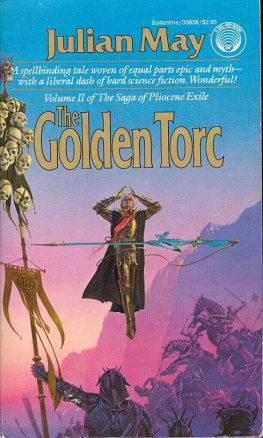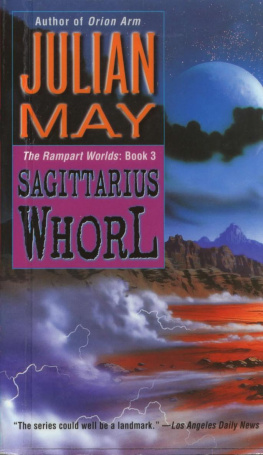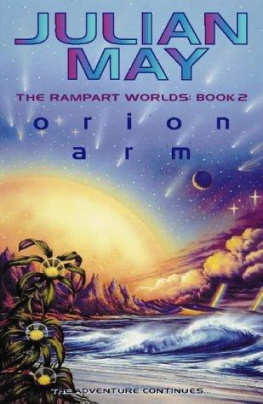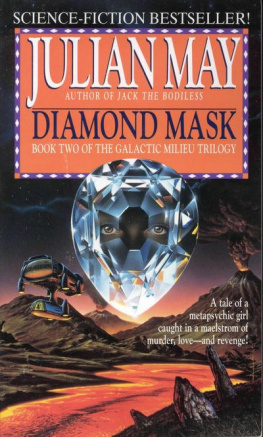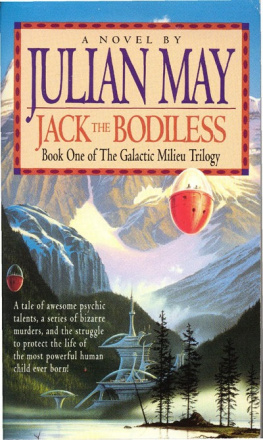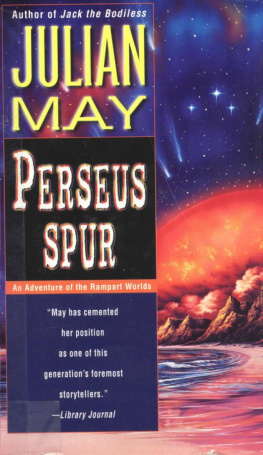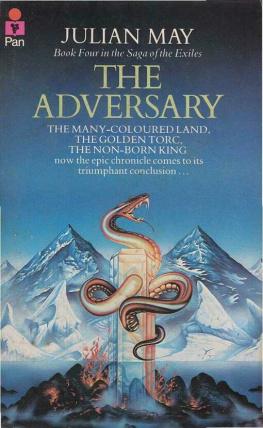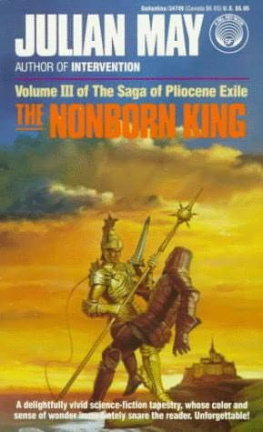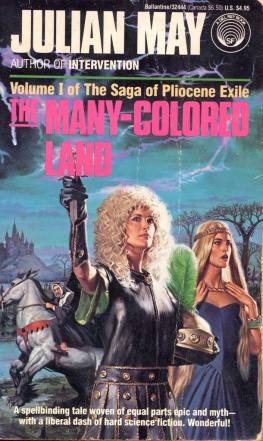The Golden Torc
Book II of the Exiles
Julian May
CONTENT
VOLUME I
THE MANY-COLORED LAND
THE GREAT INTERVENTION OF 2013 OPENED HUMANITY'S WAY to the stars, giving the people of Earth unlimited lebensraum, energy sufficiency, and membership in a benevolent civilization, the Galactic Milieu. Humanity became the sixth of the Coadunate Races, a commonwealth of planet colonizers who shared high technology and the capability of performing mental operations known as metafunctions. The latter-which include telepathy, psychokinesis, and many other powers-had lurked in the human gene pool from time immemorial, but only rarely were manifest.
By 2110, when the action of the first volume in this saga began, a kind of Golden Age prevailed. More than 700 fresh planets had been colonized by exuberant Earthlings. Humans with overt metapsychic powers were slowly increasing in number; however, in the majority of the population, the mindpowers were either meager to the point of nullity, or else latent-that is, nearly unusable, because of psychological barriers or other factors.
Even Golden Ages have their misfits, and the psychosocial structure of the Galactic Milieu had its share. A French physicist named Theo Guderian unwittingly provided these square pegs with a unique escape hatch when he discovered an apparently useless phenomenon: a one-way, fixed-focus time-warp opening into France's Rhone River Valley as it existed during the Pliocene Epoch, six million years ago. Certain that a prehistoric Eden must exist on Pliocene Earth, an increasing number of misfits prevailed upon Guderian's widow, Angelique, to let them pass through the time-portal into "Exile."
From her husband's death in 2041 until 2106, the rejuvenated Madame Guderian operated a peculiar establishment that the Galactic authorities reluctantly tolerated. Her French inn, l'Auberge du Portail, served as a front for transporting clients from Old Earth to a world six million years younger. After suffering qualms of conscience about the fate of the transportees, Madame herself ultimately passed through the one-way gate into Pliocene Exile. Operation of the time-warp was taken over by the Galactic Milieu, which had found it to be a convenient glory hole for dissidents.
On 25 August 2110, eight persons, making up that week's "Group Green," were transported to the Pliocene: Richard Voorhees, a grounded starship captain; Felice Landry, a disturbed young athlete whose violent temperament and latent mind-powers had made her an outcast; Claude Majewski, a 133-year-old paleontologist recently bereaved of his wife and colleague; Sister Amerie Roccaro, a physician and burnt-out priest who longed to become a hermit; Bryan Grenfell, an anthropologist in search of his lover, Mercy Lamballe, who had preceded him through the gate two months before; Elizabeth Orme, a Grand Master metapsychic operator deprived of her stupendous mental powers by a brain trauma; Stein Oleson, a misfit planet-crust driller, who dreamt of leading a Viking's life in a simpler world; and Aiken Drum, an engaging young crook who, like Felice, possessed latent metapsychic powers.
These eight people successfully made the jump six million years into Earth's past-only to discover, as other time-travelers had before them, that Pliocene Europe was under the control of a group of maverick humanoids from another galaxy.
The exotics were also exiled, driven from their home because of their barbarous battle-religion.
The dominant exotic faction, the Tanu, were tall and handsome. In spite of a thousand-year sojourn, there were still less than 20,000 of them on Earth because their reproduction was inhibited by solar radiation. Since their plasm was compatible with that of humanity, they had for nearly seventy years utilized the time-travelers in breeding, holding Pliocene humanity in benevolent serfdom.
Antagonistic to the Tanu and outnumbering them by at least four to one were their ancient foes, the Firvulag. These exotics were mostly of short stature and reproduced quite well on Earth.
Tanu and Firvulag actually constitute a dimorphic race-the tall ones metapsychically latent, the short ones possessed of limited operant metafunctions. The Tanu wear mind-amplifiers, collars called golden tores, to bring their powers up to operancy.
Firvulag do not require tores, and most of them are weaker in mental power than the Tanu.
For most of the thousand years that Tanu and Firvulag resided on Pliocene Earth (which they called the Many-Colored Land), they were fairly evenly matched in the ritual wars fought as part of their battle-religion. The greater finesse and more sophisticated technology of the Tanu tended to counterbalance the superior numbers of the cruder Firvulag. But the advent of time-traveling humanity tipped the scales in favor of the tall exotics. Not only did Tanu-human hybrids turn out to have unusual physical and mental strength, but humans also enhanced the rather decadent science establishment of the Tanu by injecting the expertise of the Galactic Milieu. The seventy years of time-traveling had seen nearly 100,000 humans transported to Pliocene Europe; their assimilation gave the Tanu almost complete ascendency over the Firvulag foe (who never mated with humanity and generally despised them).
The lot of humankind under the Tanu overlords is by no means grim; people who cooperate are treated very well. All rough work is done by ramapithecines, small apes who wear simple tores that compel obedience. (Ironically, these "ramas" are part of the direct hominid line that climaxed in Homo sapiens six million years later.) Humans occupying positions of trust or engaged in vital occupations under the Tanu usually wear gray tores.
These do not amplify the mind, but do allow telepathic communication between humans and exotics; the devices also incorporate pleasure-pain circuits, through which the Tanu reward or punish their minions. The tores are not easily made, requiring a rare barium component in their manufacture, and so they are not used on the majority of "normal" (that is, metaphysically nonlatent) humans, who are coerced into obedience by other means. If Tanu testing shows that an arriving time-traveler has significant latent metafunctions, the lucky person is given a silver torc.
This is a genuine amplifier similar to the gold collars worn by the Tanu-but with control circuits.
Silver-torc humans enjoy a privileged position; rarely, they may even be granted golden torcs and full freedom as citizens of the Many-Colored Land.
The eight members of Group Green, like all new arrivals, were taken for mind-testing to a Tanu fortress, Castle Gateway.
Almost at once, the Group proved to be anything but typical.
The starship captain, Richard, temporarily escaped and had a terrifying encounter with a Tanu slave-mistress, Epone, who administered the tests for latent metafunctions.
Elizabeth, the former farsensor and metapsychic teacher, discovered that passage through the time-warp had triggered restoration of the awesome mental powers she feared had been lost forever. Her discovery was noted with excitement by another Tanu, Creyn, who promised Elizabeth that a "wonderful life" lay ahead of her in the Many-Colored Land.
Stein Oleson, the huge driller, was driven temporarily insane by the trip back through time. Smashing the door of his detention cell, he was subdued only after killing a number of gray-torc bondsmen. To insure Stein's future docility, he was fitted with a gray torc of his own. His heroic physique made him a candidate for the Tanu-Firvulag ritual war, the Grand Combat. Still unconscious from his recapture, he was readied for a trip south to the Tanu capital city of Muriah.
Also torced-but with silver-was the trickster youth, Aiken Drum. The exotic testers had detected strong metapsychic latencies in him, which would be brought up to the operant level as he became accustomed to wearing the amplifier.
Next page
